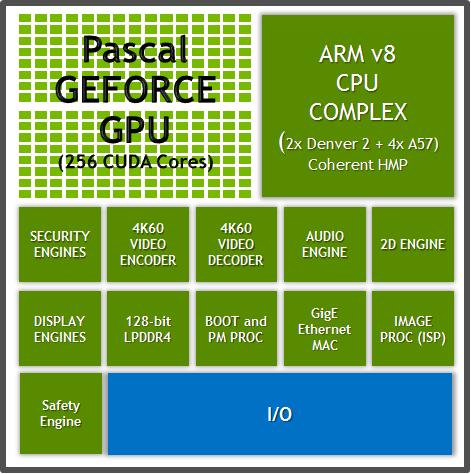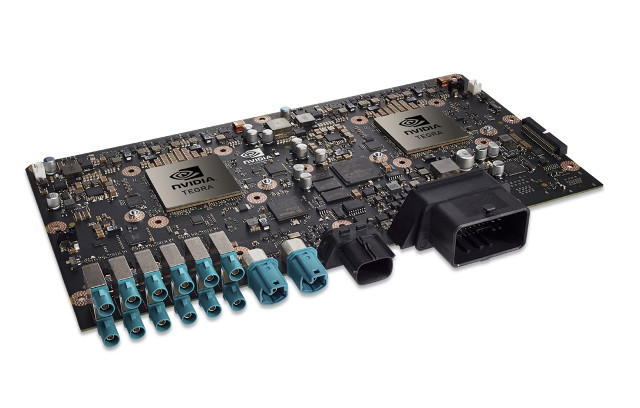Nvidia demonstrated DRIVE PX2 platform for self-driving cars at CES 2016, but did not give many details about the SoC used in the board. Today, the company has finally provided more information about Parker hexa-core SoC combining two Denver 2 cores, and four Cortex A57 cores combining with a 256-core Pascal GPU.
 Nvidia Parker SoC specifications:
Nvidia Parker SoC specifications:
- CPU – 2x Denver 2 ARMv8 cores, and 4x ARM Cortex A57 cores with 2MB + 2 MB L2 cache, coherent HMP architecture (meaning all 6 cores can work at the same time)
- GPUs – Nvidia Pascal Geforce GPU with 256 CUDA cores supporting DirectX 12, OpenGL 4.5, Nvidia CUDA 8.0, OpenGL ES 3.1, AEP, and Vulkan + 2D graphics engine
- Memory – 128-bit LPDDR4 with ECC
- Display – Triple display pipeline, each at up to 4K 60fps.
- VPU – 4K60 H.265 and VP9 hardware video decoder and encoder
- Others:
- Gigabit Ethernet MAC
- Dual-CAN (controller area network)
- Audio engine
- Security & safety engines including a dual-lockstep processor for reliable fault detection and processing
- Image processor
- ISO 26262 functional safety standard for electrical and electronic (E/E) systems compliance
- Process – 16nm FinFet

Parker is said to deliver up to 1.5 teraflops (native FP16 processing) of performance for “deep learning-based self-driving AI cockpit systems”.
This type of board and processor is normally only available to car and part manufacturer, and the company claims than 80 carmakers, tier 1 suppliers and university research centers are now using DRIVE PX 2 systems to develop autonomous vehicles. That means the platform should find its way into cars, trucks and buses soon, including in some 100 Volvo XC90 SUVs part of an autonomous-car pilot program in Sweden slated to start next year.

Jean-Luc started CNX Software in 2010 as a part-time endeavor, before quitting his job as a software engineering manager, and starting to write daily news, and reviews full time later in 2011.
Support CNX Software! Donate via cryptocurrencies, become a Patron on Patreon, or purchase goods on Amazon or Aliexpress




